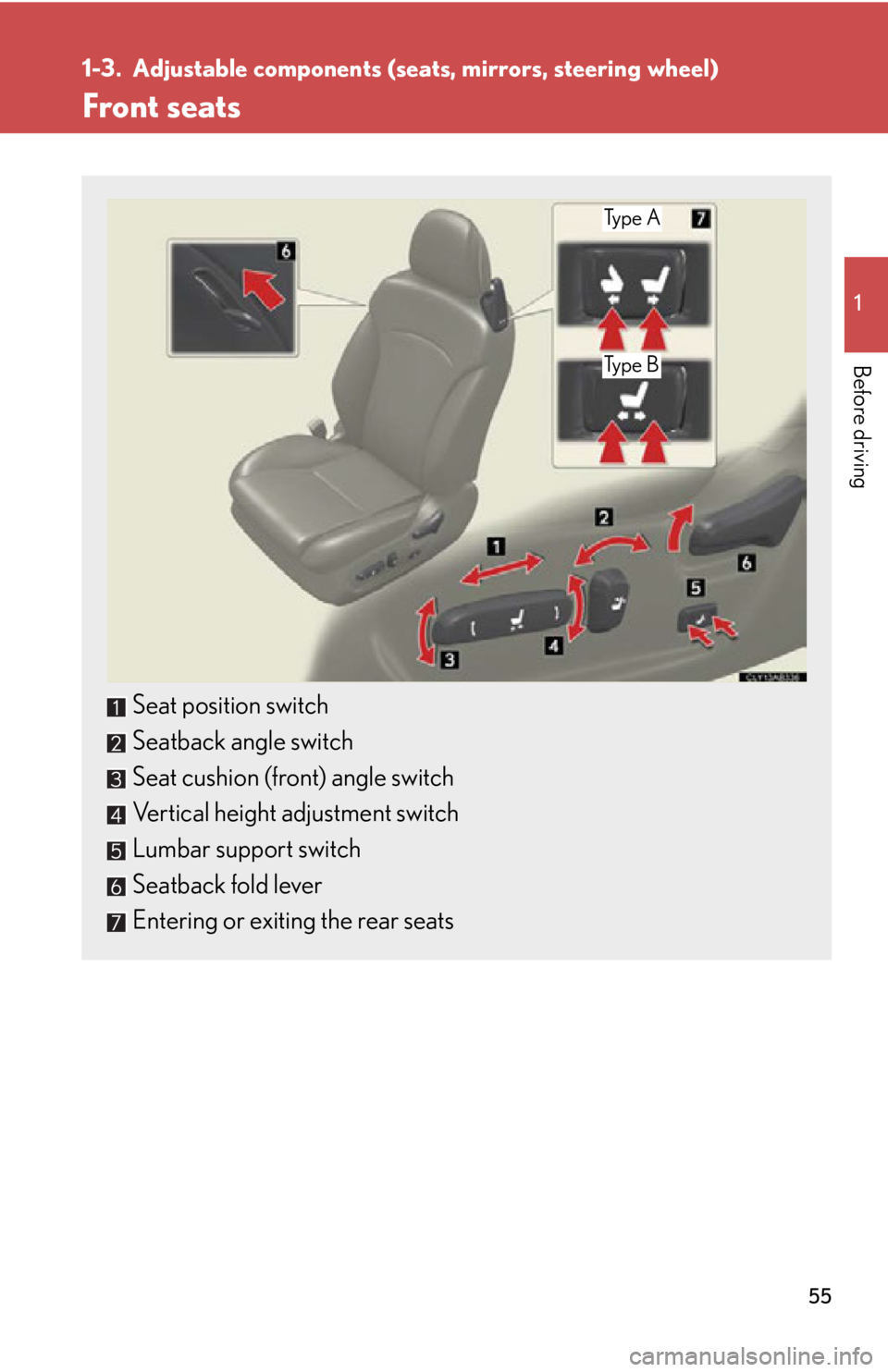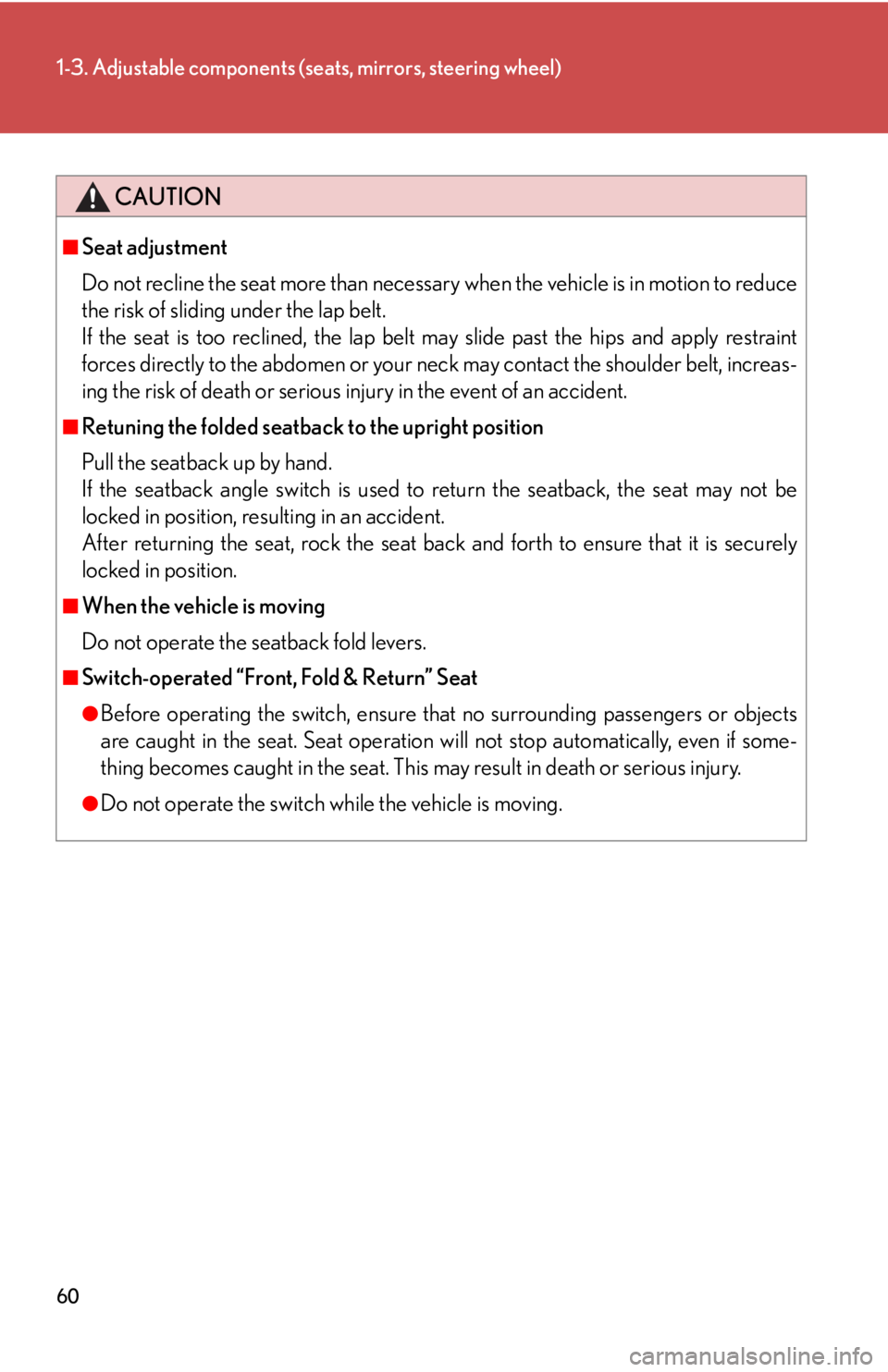seat adjustment Lexus IS250C 2012 Instrument cluster / LEXUS 2012 IS250C,IS350C OWNERS MANUAL (OM53A62U)
[x] Cancel search | Manufacturer: LEXUS, Model Year: 2012, Model line: IS250C, Model: Lexus IS250C 2012Pages: 632, PDF Size: 6.77 MB
Page 55 of 632

55
1
Before driving
1-3. Adjustable components (seats, mirrors, steering wheel)
Front seats
Seat position switch
Seatback angle switch
Seat cushion (front) angle switch
Vertical height adjustment switch
Lumbar support switch
Seatback fold lever
Entering or exiting the rear seats
Ty p e A
Ty p e B
Page 59 of 632

59
1-3. Adjustable components (seats, mirrors, steering wheel)
1
Before driving
■Switch-operated “Front, Fold & Return” Seat
●When the auto return function is on, a buzzer will sound intermittently while the
switch-operated “Front, Fold & Return” seat is in motion.
●If any seat adjustment switch or driving position memory switch is operated
after the seat is moved to the forward and fold position using the “Front, Fold &
Return” seat switch, the seat cannot be returned using the “Front, Fold & Return”
seat switch. Use a switch other than the “Front, Fold & Return” seat switch to
return the seat.
●The switch-operated “Front, Fold & Return” seat cannot operate when:
• A person or item of luggage is on th e seat or the seat belt is fastened.
• The vehicle is moving.
●Operation of the Switch-operated “Front, Fold & Return” Seat will stop if:
• The “Front, Fold & Return” seat switch is pressed again.
• Any seat adjustment swit ch or driving position memory switch is pressed.
• A person enters the seat or an item of luggage is put on the seat (during for- ward movement only).
• The vehicle starts off.
• The seat belt is fastened (during forward movement only).
■When the seatback is fully reclined
Do not use the seatback fold lever to rais e the front seat as this may prevent the
seatback from locking in place.
If the seatback will not lock, press and ho ld the seatback angle switch forward for a
few seconds to change the memorized seat position. Raise the seatback by hand
and check that it locks in position as normal.
Page 60 of 632

60
1-3. Adjustable components (seats, mirrors, steering wheel)
CAUTION
■Seat adjustment
Do not recline the seat more than necessary when the vehicle is in motion to reduce
the risk of sliding under the lap belt.
If the seat is too reclined, the lap belt may slide past the hips and apply restraint
forces directly to the abdomen or your neck may contact the shoulder belt, increas-
ing the risk of death or serious in jury in the event of an accident.
■Retuning the folded seatback to the upright position
Pull the seatback up by hand.
If the seatback angle switch is used to return the seatback, the seat may not be
locked in position, resulting in an accident.
After returning the seat, rock the seat back and forth to ensure that it is securely
locked in position.
■When the vehicle is moving
Do not operate the seatback fold levers.
■Switch-operated “Front, Fold & Return” Seat
●Before operating the switch, ensure that no surrounding passengers or objects
are caught in the seat. Seat operation will not stop automatically, even if some-
thing becomes caught in the seat. This ma y result in death or serious injury.
●Do not operate the switch while the vehicle is moving.
Page 64 of 632

64
1-3. Adjustable components (seats, mirrors, steering wheel)
■Canceling the linked door unlock operation
Close the driver's door and turn the “ENGINE START STOP” switch
OFF.
Using the wireless remote control: While pushing the “SET” button, press
on the wireless remote control until the signal beeps.
Using the door lock switch: While pressing the “SET” button, press the
lock or unlock side on the door lock switch until the signal beeps.
■Operating the driving position memory after turning the “ENGINE START
STOP” switch OFF
Memorized positions (except for the steering wheel positions) can be activated up
to 180 seconds after the driver's door is opened and another 60 seconds after it is
closed again, even after turning the “ENGINE START STOP” switch OFF.
■To cancel seat position recall
Perform any of the following operations.
●Push the “SET” button.
●Push button “1”, “2” or “3”.
●Adjust the seat using the switches (only cancels seat position recall).
■If the battery is disconnected
The memorized positions are erased when the battery is disconnected.
CAUTION
■Seat adjustment caution
Take care during seat adjustment that the seat does not strike the rear passenger or
child restraint system, or squeeze your body against the steering wheel.
STEP1
STEP2
Page 66 of 632

66
1-3. Adjustable components (seats, mirrors, steering wheel)
■Operating the seat position memory after turning the “ENGINE START STOP”
switch OFF
Memorized position can be activated up to 180 seconds after the front passenger
door is opened, even after turning the “ENGINE START STOP” switch OFF.
■To cancel seat position recall
Perform any of the following operations.
●Push the “SET” button.
●Push button “1”, “2” or “3”.
●Adjust the seat position using the switches.
■If the battery is disconnected
The memorized positions are erased when the battery is disconnected.
CAUTION
■Seat adjustment caution
Take care during seat adjustment that the seat does not strike the rear passenger or
child restraint system.
Page 67 of 632

67
1
1-3. Adjustable components (seats, mirrors, steering wheel)
Before driving
Head restraints
Head restraints are provided for all seats.
Vertical adjustment (front seats)Up
Pull the head restraints up.
Down
Push the head restraint down
while pushing the lock release
button.
Folding operation (rear seats)
Pull the lever.
When reversing etc., folding
down the head restraints
enables a better view of the area
behind the vehicle.
To return the head restraints,
raise them by hand.
Lock release button
Page 77 of 632

77
1-3. Adjustable components (seats, mirrors, steering wheel)
1
Before driving
■The steering wheel can be adjusted when
The “ENGINE START STOP” switch is in ACCESSORY or IGNITION ON mode.
■Automatic adjustment of the steering position (vehicles with driving position
memory)
A desired steering position can be entered to memory and recalled automatically
by the driving position memory. ( P. 6 1 )
■Customization that can be configured at Lexus dealer
It is possible to deactivate the auto tilt-away function.
(Customizable features P. 5 9 5 )
CAUTION
■Caution while driving
Do not adjust the steering wheel while driving.
Doing so may cause the driver to mishandle the vehicle and an accident, resulting in
death or serious injury.
Page 79 of 632

79
1
1-3. Adjustable components (seats, mirrors, steering wheel)
Before driving
Outside rear view mirrors
■The mirrors can be adjusted when
The “ENGINE START STOP” switch is in ACCESSORY or IGNITION ON mode.
■When the mirrors are fogged up
Turn on the mirror defoggers to defog the mirrors. (P. 2 5 7 )
■Folding back the mirrors
■One-touch adjustment of the mirror angle
(vehicles with driving position memory)
A desired mirror face angle can be entered to memory and adjusted automatically
by the driving position memory. ( P. 6 1 )
Mirror angle can be adjusted using the switch.
Select a mirror to adjust
(“L”: left or “R”: right)
Adjust the mirror up, down,
in, or out using the switch
Push back in the direction of the vehicle's
rear.
Page 105 of 632

105
1-7. Safety information
1
Before driving
CAUTION
■While driving
●Do not adjust the position of the driver’s seat while driving.
Doing so could cause the driver to lose control of the vehicle.
●Do not place a cushion between the driver or passenger and the seatback.
A cushion may prevent correct posture from being achieved, and reduce the
effectiveness of the seat belt and head restraint, increasing the risk of death or
serious injury to the driver or passenger.
●Do not place anything under the front seats.
Objects placed under the front seats may become jammed in the seat tracks and
stop the seat from locking in place. This may lead to an accident. The adjustment
mechanism may also be damaged.
■Adjusting the seat position:
●Take care when adjusting the seat position to ensure that other passengers are
not injured by the moving seat.
●Do not put your hands under the seat or near the moving parts to avoid injury.
Fingers or hands may become jammed in the seat mechanism.
Page 229 of 632

229
2-4. Using other driving systems
2
When driving
■The pre-collision system is operational when
●Pre-collision seat belt (type A)
• Vehicle speed is above 4 mph (5 km/h).
• The speed at which your vehicle is approaching the obstacle or oncomingvehicle exceeds 19 to 25 mph (30 to 40 km/h).
• The front occupants are wearing a seat belt.
●Pre-collision seat belts (type B)
• Vehicle speed exceeds 19 mph (30 km/h).
• The system detects sudd en braking or skidding.
• The front occupants are wearing a seat belt.
●Pre-collision brake Assist
• Vehicle speed is above 19 mph (30 km/h).
• The speed at which your vehicle is approaching the obstacle or the vehicle is greater than 19 to 25 mph (30 to 40 km/h).
• The brake pedal is depressed.
●Pre-collision braking:
• The pre-collision braking function is activated.
• Vehicle speed is above 10 mph (1 5 km/h).
• The relative speed difference between your vehicle and another vehicle that is forward of your vehicle, or the speed at which your vehicle is approaching
an obstacle is greater than 10 mph (1 5 km/h).
■Situations in which the pre-collision system does not function properly
The system may not function effectively in situations such as the following:
●On roads with sharp be nds or uneven surfaces
●If a vehicle suddenly moves in front of your vehicle, such as at an intersection
●If a vehicle suddenly cuts in front of your vehicle, such as when overtaking
●In inclement weather such as heav y rain, fog, snow or sand storms
●When your vehicle is skidding with the VSC system off
●When an extreme change in vehicle height occurs
●When the axis of the radar is out of adjustment